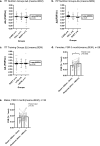Effect of 1-year daily protein supplementation and physical exercise on muscle protein synthesis rate and muscle metabolome in healthy older Danes: a randomized controlled trial
- PMID: 37266586
- PMCID: PMC10421766
- DOI: 10.1007/s00394-023-03182-0
Effect of 1-year daily protein supplementation and physical exercise on muscle protein synthesis rate and muscle metabolome in healthy older Danes: a randomized controlled trial
Abstract
Background: The skeletal muscle mass decreases with age and the responsiveness of aging muscles' protein synthesis rate (MPS) to protein intake seems to deteriorate.
Objective: This study investigated the impact of 12 months of protein supplementation with or without physical exercise training on the basal and postprandial MPS and the skeletal muscle metabolome of healthy older Danes (> 65 years, 29 females/37 males).
Methods: Subjects were randomized to follow one of five intervention groups: (1) carbohydrate, (2) collagen protein, (3) whey protein, (4) home-based light resistance training with whey protein, and (5) center-based heavy-load resistance training with whey protein. Before and after the intervention, a tracer infusion trial was conducted to measure basal and postprandial MPS in response to intake of a cocktail consisting of 20 g whey hydrolysate + 10 g glucose. In addition, the skeletal muscle metabolome was measured using gas chromatography-mass spectrometry (GC-MS) at basal state and 4 h after the intake of the cocktail.
Results: One year of daily protein or carbohydrate supplementation did not alter the basal and protein-stimulated postprandial muscle protein synthesis rate or the muscle metabolome of healthy older Danes. Basal MPS (%/h) at baseline for all subjects were 0.0034 ± 0,011 (mean ± SD). In contrast to previous studies, no difference was observed in basal MPS between males and females (p = 0.75). With the developed untargeted GC-MS methodology, it was possible to detect and tentatively annotate > 70 metabolites from the human skeletal muscle samples.
Conclusion: One year of protein supplementation in comparison to an isocaloric-control supplement seems to affect neither the MPS at basal or postprandial state nor the skeletal muscle metabolome.
Clinical trial registry: Number: NCT02115698, clinicaltrials.gov/ct2/show/NCT02115698.
Keywords: Aging; Healthy aging; Healthy older adults; Muscle metabolome; Protein supplementation; Protein synthesis; Sarcopenia; Training.
© 2023. The Author(s).
Conflict of interest statement
None of the authors declared any conflict of interest.
Figures



References
Publication types
MeSH terms
Substances
Supplementary concepts
Associated data
LinkOut - more resources
Full Text Sources
Medical
Miscellaneous

